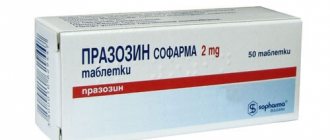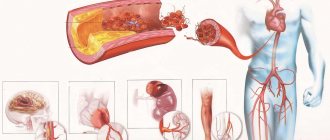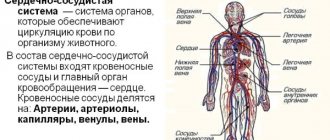What are statins?
This is a group of lipid-lowering drugs, the main task of which is to normalize the content of lipoproteins and fats in the blood by reducing the amount of triglycerides, total cholesterol, low and very low density (“bad”) and increasing high density cholesterol (“good”). This process leads to a reduction in the risk of developing atherosclerosis and its consequences - high blood pressure, ischemia, heart attack and stroke.
Some of the best drugs include:
- Simvastatin - tablets from light pink to pink with a lilac tint, round and biconvex, with 10-40 mg. Prescribed for primary hypercholesterolemia, used in the prevention of myocardial infarction. Take once a day, at night. Contraindications for use are liver failure, acute liver diseases, childhood, pregnancy, breastfeeding, hypersensitivity to the drug, alcohol abuse. Average price – 500 rub. for 30 pieces of 10 mg, depends on the trade name and manufacturer.
- Pravastatin – white tablets of 10 and 20 mg, with the main substance pravastatin sodium. It is used in the complex treatment of hypercholesterolemia and mixed dyslympidemia, and is also prescribed as a supplement to the main diet. As a preventive measure, it is effective for coronary heart disease, angina pectoris, heart attack, diabetes mellitus, obesity, and vascular atherosclerosis. Contraindicated during pregnancy, lactation, liver failure, and after transplant operations. The average price of the drug is 3,000 rubles.
- Lovastatin is a white, water-insoluble crystalline powder prescribed for primary hypercholesterolemia with types IIa and IIb. Taken once a day, before bedtime. Contraindicated in case of elevated levels of transaminases in the blood plasma, renal and liver failure, pregnancy, lactation, and childhood. Minimum price – 90 rub.
- Atorvastatin. The active ingredient is calcium trihydrate. The drug is available in the form of tablets or capsules with a dosage of 10 to 80 mg. Indications for use are dysbetalipoproteinemia, hyperlipedemia, hypercholesterolemia, contraindications - individual intolerance, liver pathologies, renal failure. The cheapest is Atorvastatin 0.01 g, produced by Pranafarm, its price is 100 rubles, the package contains 30 tablets, the most expensive is Atorvastatin 0.02 g, manufactured by Vertex, the price of a package of 90 tablets is 780-790 rubles.
- Rosuvastatin - film-coated tablets from light pink to pink, biconvex, taken once a day, at night, 1 tablet. The main element is calcium rosuvastatin, of which 1 pc. contains from 5 to 40 mg. Indications for use: primary and mixed hypercholesterolemia, familial homozygous hypercholesterolemia, hypertriglyceridemia, also used to reduce the rate of progression of atherosclerosis and primary prevention of cardiovascular complications. Contraindications: hypersensitivity, lactose intolerance, lactase deficiency, childhood, liver disease, impaired renal function. The price of the drug is from 390 rubles.
- Pitavastatin is available in tablets with a dosage of 1-4 mg, which are taken 1 pc. for the night. Indications for use: pure hypercholesterolemia, pure hyperglyceridemia, unspecified hyperlipidemia. It is also used as a prophylaxis to reduce the risk of mortality from coronary artery disease. Contraindications include severe liver failure, impaired motor activity, pregnancy, breastfeeding, childhood, combined use with Cyclosporine. The average price for the drug in Russia is 500 rubles.
In addition to statins, this category of drugs includes fibrates, the main advantage of which is a more effective reduction in triglycerides and less toxicity.
The following drugs are especially popular:
- Fenofibrate is available in capsules and tablets under various brand names. It is prescribed for adults in dosages of 200-400 mg/day, divided into three doses, for children - 5 mg per kg per day for hyperlipoproteinemia of types IIa, IIb, III and IV. Contraindications are severe liver and kidney dysfunction, pregnancy and lactation.
- Clofibrate - produced in capsules of 0.25 and 0.5 g, which are taken 3 times a day, 2-3 pieces. Used in complex therapy for vascular sclerosis, diabetes mellitus, retinopathy, hyperlipidemia and triglyceridemia. Contraindicated in case of serious pathologies of the liver and kidneys, during pregnancy and lactation.
- Bezafibrate - available in the form of tablets of 0.2 g in a package of 50 pieces. Prescribed for hyperlipoproteinemia and lipid metabolism disorders in dosages of 0.2-0.3 g 2-3 times a day. Contraindicated in patients with severe pathologies of the liver and kidneys, women during pregnancy and breastfeeding.
In some cases, when there are no clear indications for the use of statins or fibrates, but there are risk factors such as high blood pressure, cholelithiasis, chronic inflammation of the gallbladder, diabetes mellitus, smoking, medications that reduce the absorption of cholesterol from food or dietary supplements are prescribed aimed at cleansing blood vessels from atherosclerotic plaques. The most popular products from the first group are “Orlistat” and “Ezetrol”, and from the second - “Omega Forte”, “Tykveol”, “Golden mumiyo”.
Specifics of the group and their classification
Depending on the mechanism of action and the level of influence on a particular stage of lipid metabolism, there are three groups of drugs. Among them are:
- drugs that stimulate the depletion of cholesterol reserves in the liver and its reabsorption - cholestyramine;
- drugs that affect the stages of cholesterol transport and inhibit LDL synthesis - statins, fibrates and others;
- means that promote the rapid removal of fats and their derivatives from the body - probucol.
Classification of lipid-lowering drugs
Also, antioxidants, antiplatelet agents and angioprotectors are used in the treatment of lipid metabolism disorders. These drugs do not affect the processes of cholesterol synthesis and metabolism, but they prevent the appearance of damage to the vascular wall and the formation of atherosclerotic plaques.
Lipid-lowering drugs cannot be used as monotherapy. Their intake must be accompanied by a low-lipid and low-carbohydrate diet. It is also worth giving up bad habits such as smoking and alcohol. It is recommended to add regular physical activity to your daily plan, this way the therapeutic effect will be achieved much faster.
The dosage of the drug depends directly on the type of hypercholesterolemia, so the dose is selected by the doctor individually for each patient. Quality control of therapy should be carried out once every 4 weeks, taking into account lipid profile parameters and drug tolerability.
Hypercholesterolemia
Particular attention should be paid to patients with chronic liver failure. Lipid-lowering drugs have a direct effect on the synthesis of bile acids, which leads to changes in the activity of liver transaminases. Therefore, when choosing an effective dose, liver test results should be taken into account. As for elderly patients, there are no special prescriptions for them, and the dosage of the drug is based on general principles, as for patients of other age groups.
As a rule, the drugs are recommended to be taken before dinner, since cholesterol synthesis slows down at night.
How do statins work?
They block glycoproteins responsible for the production of cholesterol, and also increase the number of receptors that capture low-density lipoproteins and reduce their activity in the blood, which leads to increased levels of high-density lipoproteins. Statins also prevent the absorption of cholesterol from food, and thus the lipid-lowering effect of taking the drug is realized.
The use of statins does not disrupt the production of hormones by the adrenal glands and sex glands.
The atherosclerotic effect of statins is:
- in a positive effect on the inner surface of blood vessels, as a result of which their plasticity increases and the structure improves, which, in turn, ensures good blood flow and prevents the development of tissue ischemia;
- in blocking the synthesis of cytokines responsible for the development of inflammation, which reduces the growth of cholesterol plaques and reduces the possibility of their attachment to blood vessels;
- in the inactivation of macrophage cells, which produce substances that promote loosening of plaques and their detachment, which leads to vascular thrombosis;
- in providing an antioxidant effect.
Therapeutic effect
Cholesterol is an organic compound that is the basis for healthy cell membranes. This substance is mainly produced by the body itself, about 1/5 of the required share comes from food.
There are two types of cholesterol:
- “Harmful”, promoting the appearance of atherosclerotic formations on the walls of arteries (LDL).
- “Useful”, helping to restore the damaged integrity of tissue cells (HDL).
The production of enzymes that provoke the release of cholesterol occurs in the cells of the liver and adrenal glands. Medicines of the statin group help inhibit this enzyme and lower cholesterol.
Statins are of particular value for heart diseases - according to doctors, these drugs significantly reduce the mortality rate of heart patients.
Specifics of the therapeutic effects of medications:
- Reducing the concentration of LDL levels, which provokes obliteration of blood vessels by fatty deposits.
- Increasing “useful” cholesterol levels - HDL.
- Reducing the risk of vascular diseases.
- Relief of inflammatory processes inside the vascular walls, reduction of spasms, restoration of the integrity of the endothelial coating of blood vessels. This effect
- helps reduce the risk of cholesterol deposits.
- Improving the flow properties of blood, preventing thrombosis.
- Prevents oxidation and tissue breakdown.
- Inhibition of cell growth that contributes to the formation of blood clots and lipid plaques.
Indications for prescribing statins
The main factor determining the prescription of these drugs is high cholesterol levels. It is detected using a blood lipid test.
But, in addition, statins are prescribed:
- for preventive purposes to avoid chronic heart failure and strokes in people at risk;
- during the recovery period after myocardial infarction or bypass surgery, stenting, angioplasty and other similar operations;
- in preparation for coronary artery bypass surgery;
- for the treatment and prevention of coronary heart disease;
- to reduce the rate of development of atherosclerosis;
- for the treatment of fatty liver disease not associated with alcohol exposure;
- for metabolic disorders (obesity, diabetes).
Many doctors are inclined to believe that before surgical interventions, after a stroke and heart attack, as well as with progressive ischemic heart disease and the occurrence of acute coronary syndrome, taking statins is mandatory, since cleaning blood vessels (essentially secondary prevention) significantly prolongs life.
Indications for use
According to doctors, treatment with statin drugs is recommended in the following cases:
- Prevention of progression of atherosclerosis. Basically, these drugs are prescribed to patients who already have a similar diagnosis in order to prevent possible complications. Most often, statin therapy is recommended for atherosclerosis of the vessels of the cervical and cerebral spine, lower extremities, and coronary artery disease.
- Hereditary tendency to develop atherosclerosis against the background of elevated LDL levels. For such patients, taking statins is recommended to prevent the development of cardiovascular diseases.
- Patients “aged” are women over 55 and men over 45 years old.
- For diabetics - in the absence of obvious contraindications.
- Those who are at risk of heart and vascular diseases - smokers, hypertensive patients, people with elevated levels of harmful lipids in the blood, obese patients.
According to doctors, an important condition for the success of statin therapy is adherence to a low-carbohydrate diet, cessation of tobacco addiction, and regular physical activity.
Contraindications
An absolute ban on taking statins is imposed:
- for liver and kidney diseases in active phases;
- with increased levels of ALT and AST (more than three times) and CPK (more than five times);
- during pregnancy and breastfeeding;
- with individual intolerance;
- in childhood - up to 10 years (in exceptional cases - up to 8 years).
It is also prescribed with caution:
- for liver diseases that are in stable remission;
- with fatty hepatosis;
- if you have type 2 diabetes;
- women over 65 years of age with a tendency to be thin.
New dietary fiber products with hypolipidemic effect
The role of plant fiber in normalizing cholesterol metabolism is explained by its ability to absorb excess fat from the intestinal lumen and remove it from the body. But this is not the only advantage of dietary fiber. Fat metabolism depends on the state of the intestinal microflora. If it is imbalanced, a high level of atherogenic lipids in the blood is possible, even with proper nutrition.
Plant fibers have the property of normalizing the bacterial composition of the intestinal contents; they are classified as prebiotics. These are food components that are not affected by pancreatic enzymes, but are processed by beneficial microorganisms.
Dietary fiber in foods
The main biological effects of dietary fiber:
- inhibit the progression of atherosclerosis;
- absorb toxic compounds from the intestines;
- lower blood glucose and cholesterol levels;
- stimulate the growth of symbiotics (normal microflora);
- participate in the formation of B vitamins;
- enhance intestinal motility;
- promote the absorption of magnesium and potassium;
- accelerate the breakdown of fat;
- prevent tissue destruction by free radicals.
Therefore, it is recommended, in addition to reducing animal fats in the diet, to include fresh vegetables and fruits, berries, bran, whole grain cereals and bread, legumes and nuts in the menu every day. If dietary nutrition is insufficiently effective, medications containing dietary fiber are additionally prescribed. The most effective ones include:
- Mucofalk – contains plantain seeds (psyllium);
- Florolact consists of 3 types of fibers - lacthiol, inulin, gum arabic;
- Bionorm, it includes activated lignin, lactulose, microcrystalline cellulose;
- Polyphepane is a hydrolytic lignin.
About dietary fiber and its role in human nutrition, watch this video:
Side effects
In most cases, they arise as a result of non-compliance with dosages and/or duration of treatment, but even in this case their frequency fluctuates at the level of 1-2%.
The main negative manifestations include:
- from the gastrointestinal tract: problems with stool, flatulence, sudden weight loss, lack of appetite, heartburn, nausea, inflammatory processes in the pancreas, the formation of fatty and fibrous areas in the liver, an increase in liver enzymes in the blood;
- from the nervous system: unstable mood, problems with sleep and memory, headaches and dizziness, seizures, increased risk of Alzheimer's and Parkinson's diseases;
- from the reproductive and urinary system: sexual dysfunction, tubulopathy, the appearance of proteins in the urine, renal failure;
- from the musculoskeletal system: weakness and pain in muscles and joints, destruction of muscle tissue;
- from the cardiovascular system: surges in blood pressure, lack of platelets in the blood, nosebleeds, pain in the heart area;
- on the skin: increased sweating, allergic reactions, intolerance to sunlight.
Natural lipid-lowering drugs
Their list includes products made from plant ingredients. They differ from synthetic drugs in their mild effect on the body and the need for long-term use. Their main advantage is that they have a complex effect, that is, they not only lower cholesterol levels and normalize lipid metabolism, but also significantly improve blood composition, and also have a positive effect on the functioning of the entire cardiovascular system.
Mukofalk
A modern dietary fiber preparation with several active ingredients. It contains pectin and five types of bran:
- Soy;
- Rice;
- Wheat;
- Corn;
- Oatmeal.
When using Mucofalk, a fraction is formed in the small intestine that binds bile acids. At the same time, there is a decrease in their reabsorption in the terminal ileum, which leads to a gradual decrease in the level of cholesterol in the blood fluid.
The drug is intended not only to normalize the lipid profile and improve blood quality. It is recommended for use for:
- Constipation;
- Hemorrhoids;
- Irritation of the intestinal mucosa;
- Functional diarrhea;
- Intestinal damage of various etiologies.
It is also prescribed to pregnant women with impaired functioning of the digestive tract and to persons who have recently undergone surgery in the anorectal area.
Release form Mucofalk - granules made from crushed dietary fiber. They are packaged in single-use sachets. The contents of the sachet are poured into a glass of warm water and stirred thoroughly. The suspension is drunk 3-4 times a day. Lipid-lowering therapy with Mucofalk lasts about 3 weeks. If the lipid profile indicators do not return to normal, then treatment is extended to 30-45 days, but only on the recommendation of a doctor.
You can purchase a package of the drug with 20 sachets of 5 g granules for 400-500 rubles. It has few analogues: Nutrikon Phyto, Fukoksan and Nutrilight.
Atheroclephitis
A popular drug with a lipid-lowering effect. It is not yet included in the Russian Drug Register, but is successfully used in the treatment of various diseases associated with impaired lipid metabolism and excess cholesterol. Atheroclephitis includes:
- Red clover extract;
- Vitamin C;
- Nicotinamide;
- Extract from stems and leaves of hawthorn.
The product is available in the form of alcohol tincture and capsules. The second form of the drug is often prescribed to persons for whom medications containing ethyl are contraindicated for medical reasons.
Atheroclephitis is used in the fight against the following diseases:
- Mild form of hyperlipidemia;
- Atherosclerosis;
- Cerebrovascular accident;
- Thrombosis;
- Hyper- or hypotension.
It is also suitable for preventing the formation of sclerotic plaques and is combined with medications for the treatment of many cardiovascular pathologies.
Despite the natural composition, the drug is not recommended if you have:
- Individual intolerance to active components;
- Problems with the liver or kidneys;
- Alcoholism (applies only to tinctures);
- Cancerous tumor in the brain.
Are they really that safe?
A fairly large number of side effects make people afraid of taking statins, while few people think that the possibility of a heart attack or stroke with atherosclerosis is many times higher, and their consequences are unpredictable and can cause complete incapacity.
If we rely on statistics, then according to the US National Association, obtained after treating 470,000 people, it says the following:
- with regular use of statins for at least 5 years, the number of heart attacks is reduced by 1/3, and strokes by 1/4, and in the presence of diabetes mellitus these figures are even more significant;
- in most cases, patients do not report any side effects;
- discomfort in the intestines (constipation, bloating, pain, etc.), as the most common manifestation, is eliminated with the help of a special diet;
- the risk of liver failure does not increase from taking statins;
- only in 3 people out of 1000, the “liver test” indicators exceed the norm by 3 times, and in this case the drug is discontinued, and if the concentration of enzymes does not exceed the required indicators by 3 times, then the adjustment is achieved by reducing the dose or changing the drug to a higher one suitable;
- no more than 5 out of 1000 people experience muscle pain and weakness, which is simultaneously manifested by a 5-fold increase in creatine kinase in blood biochemistry, which requires a refusal to take medications;
- an extremely rare complication - the breakdown of muscle tissue usually occurs with the simultaneous use of statins with other groups of drugs - fibrates, macrolides and / or antitumor drugs, in this case it is necessary not only to discontinue the drugs, but also to carry out cleansing procedures from breakdown products using hemodialysis or plasmapheresis .
Drugs that inhibit the absorption of cholesterol in the intestine
By slowing down the absorption of cholesterol from food in the intestines, these drugs reduce its concentration in the blood. The most effective of this group of remedies is guar. It is a herbal dietary supplement obtained from the seeds of hyacinth beans. It contains a water-soluble polysaccharide, which forms a kind of jelly upon contact with liquid in the intestinal lumen.
Guarem mechanically removes cholesterol molecules from the intestinal walls. It accelerates the excretion of bile acids, leading to increased uptake of cholesterol from the blood into the liver for their synthesis. The drug suppresses appetite and reduces the amount of food eaten, which leads to a decrease in weight and blood lipids. Guarem is available in granules, which should be added to liquid (water, juice, milk). The drug should be combined with other antiatherosclerotic drugs.
Side effects include bloating, nausea, intestinal pain, and sometimes loose stools. However, they are insignificantly expressed, occur rarely, and go away on their own with continued therapy.
Basic rules for taking statins
Like any medications, they must be taken strictly following the instructions and recommendations of the doctor, but there are several nuances that increase the effectiveness of therapy:
- the maximum effect is achieved when taking the medicine 1.5-2 hours before bedtime;
- You can't use grapefruit juice for drinking, because... it makes it difficult to remove decay products from the body, which can provoke an overdose;
- it is necessary to follow a diet, the main points of which are a varied diet with plenty of fish, vegetables and fruits in the diet and limiting the amount of salt, fatty and fried foods, and alcohol;
- you should stop smoking;
- Doing dosed (no more than 1 hour 3-4 times a week) physical activity in the fresh air will have a beneficial effect on the condition of blood vessels.
Main classification
If we consider lipid-lowering drugs in general, their mechanism of action is clear. However, each specific drug has its own characteristics. Before describing them, let's look at how the classification compiled by experienced specialists distributed lipid-lowering drugs.
Thus, medications sold in modern pharmacies that affect cholesterol levels in the body can be divided into three types:
- depleting cholesterol reserves in the liver, inhibiting the process of its absorption in the intestines;
- inhibiting lipoprotein synthesis;
- accelerating metabolic processes and removing lipids from the body.
The first type includes bile acid sequestrants. The second includes statins, fibrates, nicotinic acid. The third one is Probucol, choleretic drugs.
As noted above, lipid-lowering drugs are a special group of drugs that can increase the presence of good cholesterol and inhibit bad cholesterol.
Can statins be combined with other drugs?
According to WHO and the American Heart Association, the negative effects of these drugs increase when they are combined with thiazide diaretics, macrolides, calcium antagonists and antibiotics. When combined with beta blockers, antiplatelet agents and ACE inhibitors, the mutual enhancement of the active substances has a more effective effect.
With very high cholesterol levels - more than 7.4 mmol/l, simultaneous use of statins and fibrates is possible, although the risk of myositis and rhabdomyolysis from this combination is quite high.
Choice of drugs
Lipid-lowering drugs can be prescribed only after a complete blood test. Each of the groups has its own target impacts:
- lowering total cholesterol and low-density fats - using statins;
- increasing “good cholesterol” - fibrates or medications with nicotinic acid;
- reduction of triglycerides - fibrates, high dosages of statins, Niacin;
- combined disorder of fat metabolism - statins or their combination with fibrates.
After receiving the result of the patient’s lipid profile, the doctor prescribes the necessary lipid-lowering drug.
The simultaneous use of 2 drugs from different groups is indicated if there is insufficient effectiveness or the need for an enhanced and rapid decrease in low-density and very low-density lipoproteins. Combination therapy is used if it is necessary to reduce the dose of one of the drugs due to severe side effects.
Natural statins for cerebral vessels.
To prevent atherosclerosis or to help prescribe medications, you should consume foods containing:
- vitamin C – citrus fruits, rose hips, bell and hot peppers, black currants;
- vitamin PP and B3 – meat, red fish, cereals, green vegetables, nuts, oyster mushrooms;
- Omega-3 and Omega-6 fatty acids – sea fish, shrimp, krill, vegetable oil;
- monacolin – fermented red rice;
- curcumin – turmeric;
- policosanol – sugar cane;
- resveratrol – grape skins, red wine;
- pectin – apples, carrots, cabbage, bran, legumes, buckwheat and pearl barley;
- allicin – garlic, onion.
You can also make infusions and decoctions from dandelion root, blue cyanosis, white mistletoe, golden mustache, fenugreek and other medicinal plants containing statins.
In conclusion, I would like to say that, despite the possible harm that statins can cause to the body, the benefits of taking them are much higher and are as follows:
- during the first five years, mortality from cardiovascular diseases decreases by 40%;
- the risk of stroke and heart attack is reduced by 30%;
- with continuous use, cholesterol levels are reduced by half compared to the initial values, which contributes to the disappearance of atherosclerotic plaques and, as a result, improvement of blood flow.
"Probucol." Properties
This drug is an antioxidant. It moderately affects the levels of good and bad cholesterol in the blood. In particular, this lipid-lowering drug works in a slightly different way compared to the ones listed above. It does not increase the concentration of HDL, but reduces it. Activation of non-receptor pathways for the removal of LDL from the blood when taking Probucol is thus the hypolipidemic property.
This drug is more experimental than therapeutic, but it is still used in medical practice. Many properties of Probucol have not yet been studied. It is well tolerated by patients, but without a solid evidence base for its benefits, doctors still prefer to prescribe other lipid-lowering drugs to their patients for long-term and safe therapy.
Contraindications for use
Despite the fact that statins (especially the new generation) have a small number of side effects, they still have some contraindications:
- severe diseases of the kidneys, liver and thyroid gland;
- hypersensitivity (allergy) to the components of the composition;
- hereditary dysfunction of the musculoskeletal system;
- period of pregnancy and lactation, children under 18 years of age.
In addition, because the health risks are too high, taking statins is not recommended in the following situations:
- engaging in sexual activity without using reliable contraceptives (especially young women of reproductive age);
- the presence of serious disturbances in the functioning of the endocrine system, hormonal imbalances and taking hormonal medications;
- joint therapy with fibrates, niacin, macrolide antibiotics, cytostatics and antifungal agents.
These contraindications are not absolute, however, in such situations, doctors prescribe statins only in cases of extreme necessity and monitor their use with special care.
Alcohol compatibility
The simultaneous use of statins with alcoholic beverages (including weak alcohol) is strictly prohibited: such a combination has a detrimental effect on liver cells, causing toxic damage.
At best, drinking ethanol will lead to increased adverse reactions in the body, and at worst, due to the massive destruction of hepatocytes, they will be replaced by connective tissue, and necrosis or cirrhosis of the liver will begin to develop.
Complications resulting from atherosclerosis
As a result of atherosclerosis, a chronic autoimmune process often develops in atherosclerotic plaques. The connective tissue grows and this leads to slow deformation and narrowing of the lumens, thereby causing a chronic, slowly increasing insufficiency of blood supply to the organ that is fed through the affected artery. It is also possible that the lumen may be blocked by a blood clot or the contents of an atherosclerotic plaque that has disintegrated.
As a result, the most severe complications of vascular atherosclerosis are stroke, heart attack (tissue necrosis) and gangrene in the organ that is supplied by this artery.
A stroke is an acute circulatory disorder in the brain. A distinction is made between ischemic stroke (a cholesterol plaque or blood clot blocks a vessel) and hemorrhagic stroke (bleeding in the brain, often a consequence of high blood pressure). Thus, through stroke, complications resulting from atherosclerosis lead to neurological problems, including paralysis.
When talking about a heart attack, they most often mean myocardial infarction (a consequence of atherosclerosis of the coronary vessels), a lesion of the heart. In this case, necrotic changes in the tissues of the heart muscle are irreversible; a connective tissue scar will remain. And in the future, this scar will interfere with normal blood flow in the vessels of the heart.
In the case of atherosclerosis of the vessels of the lower extremities, complications in the form of gangrene often lead to amputation.
All these conditions and diseases are life-threatening and often lead to disability.
Treatment of vascular atherosclerosis
Treatment of atherosclerosis can be medicinal and surgical.
Treatment of cerebral atherosclerosis is, of course, medication. Prescribed drugs that:
- dilate blood vessels in the brain;
- strengthen the elasticity of the vascular wall;
- improve metabolism at the cellular level of the brain;
- lower the level of cholesterol in blood vessels;
- relieve vascular spasms.
In the treatment of atherosclerosis of the vessels of the lower extremities, in addition to taking medications, physiotherapeutic treatment is also used. In the presence of trophic ulcers, antibiotic ointments are used.
In the treatment of atherosclerosis of the vessels of the lower extremities, surgical intervention is also allowed, but usually this is a last resort. Surgery is prescribed in case of pronounced ischemia and the occurrence of very severe complications.
The need and extent of surgical intervention is determined by the surgeon. Surgical treatment of atherosclerosis does not provide a complete cure. The complication is eliminated, not the cause that caused it (atherosclerosis). Therefore, after surgery, changes in lifestyle, nutrition and conservative treatment are mandatory.
The following are recommended as general measures:
- treatment of a concomitant disease that aggravates atherosclerosis (for example, diabetes mellitus, hypertension, etc.),
- smoking cessation,
- low cholesterol diet,
- moderate physical activity,
- in case of atherosclerosis of the vessels of the legs - wearing comfortable shoes.
Fibrates or statins: how they differ and which is better
There are three key points in total:
- Fibrates have the ability to affect triglycerides. What the latter cannot do.
- For drugs of this type, a wider scope of application is typical. Simultaneous influence on several factors of atherosclerosis and its manifestations.
- Fibrates are easier to tolerate. They do not have many side effects, and they themselves do not pose a danger to health and life.
Despite this, statins are more popular among patients. Although, in fact, both are completely different medicines. They act differently, only the indications overlap. Therefore, you should not look for the best drug. This is a useless exercise. You need to start from the specific clinical situation.
Fibrates are powerful lipid-lowering drugs to combat excess cholesterol and atherosclerosis. With the right medicine and the right dosage, the likelihood of side effects is minimal.
Classification and list of drugs
| Generation | Active substance |
| 1 | clofibrate (not used due to the risk of developing malignant tumors) |
| 2 | gemfibrozil, bezafibrate |
| 3 | fenofibrate, choline fenofibrate, ciprofibrate |
The main classification of products is based on the active substance.
Medicines based on bezafibrate
They belong to the category of modern. Although formally this is the second generation. They are quickly absorbed into the blood and leave the body just as quickly. They carry a minimum of risks and practically do not provoke side effects.
The maximum course of therapy is a month. If necessary, it is repeated in the same or higher dosage. At the discretion of the treating specialist. Take the product strictly before meals.
List of trade names: Bezapil, Bezafibrate, Oralipin.
Fibrates based on Gemfibrozil
Hemofibrozil is a drug from the group of second-generation fibrates. Due to bioavailability and low risks, it is considered universal and well tolerated. The trade name is identical to the name of the active substance.
Products based on Fenofibrate
Medicines based on fenofibrate are new, third generation fibrates. It is very popular among doctors. And this is well deserved: the list of side effects is minimal, and they rarely occur.
In addition, the product is quickly absorbed and acts for a long time, but without harm to the body. Another useful quality is that Fenofibrate affects the rheological properties of blood. Works as a mild antiplatelet agent.
List of new generation fibrates: Traikor, Grofibrat, Exlip and others. On the shelves you can find many products with a similar active substance.
Medicines based on Choline Fenofibrate
They differ little from the previous class and also belong to the third generation. They are characterized by greater bioavailability and have a more effective effect on harmful factors. Due to the fact that it is metabolized directly in the tissues of the body. Essentially, this is a modification of Fenofibrate.
There are several trade names: Choline Fenofibrate, also Trilipix.
Preparations based on Ciprofibrate
Also lipid-lowering drugs of the latest generation. Safe and effective. Can be used if the previous ones are intolerable by the patient.
On the shelves you can find such a name as Lipanor.
The doctor selects the medications. You cannot prescribe treatment without permission. Is it dangerous.











